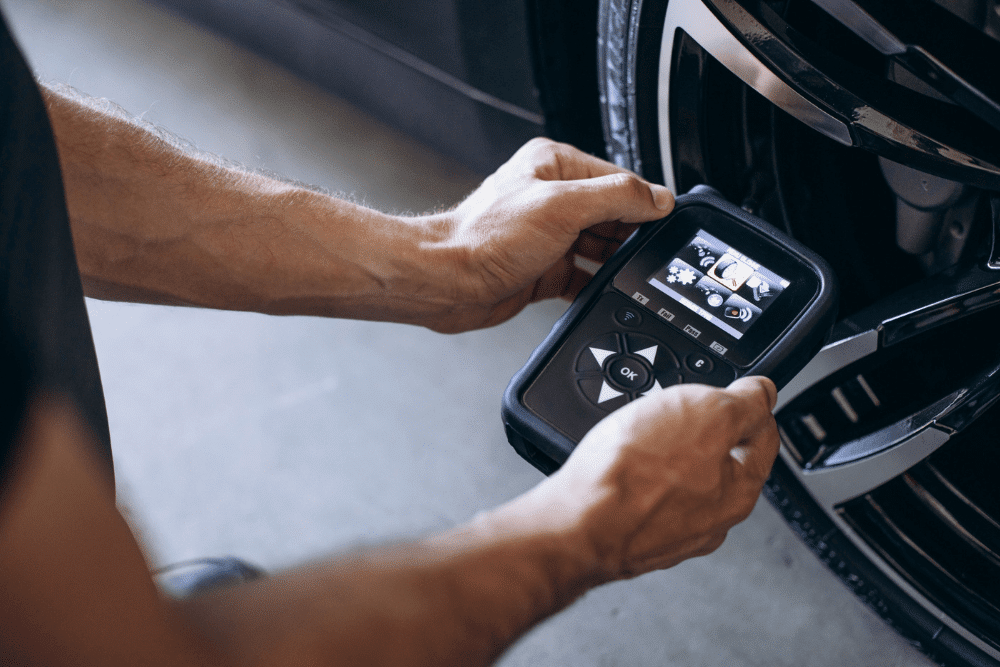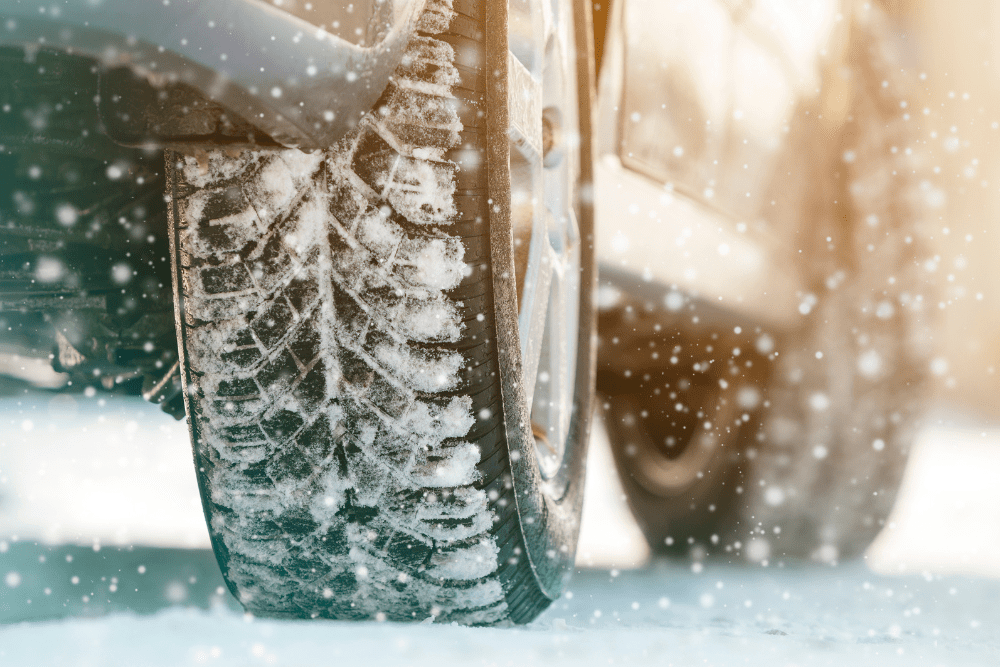Winter Tire Pressure & Driving Safety in Minnesota
Yes, cold weather dramatically affects tire pressure, and it’s one of the biggest threats to your winter driving safety. For every 10-degree temperature drop, your tires lose 1-2 PSI, which means a typical Minnesota cold snap can take you from properly inflated to dangerously underinflated overnight. Low tire pressure reduces traction on ice and snow, extends your stopping distance, and compromises your vehicle’s safety systems when they matter most. At Arvu Auto, we’ve seen how proper tire pressure monitoring prevents winter accidents and breakdowns across Long Lake, Watertown, and Cokato.
In this guide, we’ll show you how temperature changes impact your tires, how often you should check pressure during winter months, what safe PSI levels look like for Minnesota roads, and why your dashboard warning light might not alert you until it’s too late.

The Science Behind Winter Tire Pressure Loss
Cold air contracts, reducing the volume of air inside your tires. When temperatures plunge from 70°F in autumn to 10°F in January, your tires can lose 6-12 PSI without any leaks or damage.
What happens when tire pressure drops:
- Reduced road contact: Underinflated tires have less surface area gripping the road
- Longer stopping distances: Takes more time and space to brake safely on snow and ice
- Poor fuel efficiency: Costs you more money at the pump throughout winter
- Uneven tire wear: Leads to premature replacement and unnecessary expenses
- Compromised safety systems: Traction control and anti-lock brakes can’t function properly
How Temperature Changes Impact Your Tire Pressure
| Outside Temperature | Expected Tire Pressure Loss | Example Scenario |
|---|---|---|
| 40°F (Mild Fall Day) | Baseline (0 PSI loss) | Your tires read 34 PSI – perfect |
| 30°F (Cool Morning) | 2 PSI loss | Pressure drops to 32 PSI |
| 20°F (Cold Day) | 4 PSI loss | Pressure drops to 30 PSI |
| 10°F (Harsh Winter) | 6 PSI loss | Pressure drops to 28 PSI |
| 0°F (Extreme Cold) | 8 PSI loss | Pressure drops to 26 PSI – WARNING LIGHT |
| -10°F (Dangerous Cold) | 10 PSI loss | Pressure drops to 24 PSI – UNSAFE |
This chart shows why checking your tire pressure once in October isn’t enough. A single cold snap can take you from safe to dangerous in a matter of hours.
What Your Tire Pressure Warning Light Really Means
Here’s something most drivers don’t know: your tire pressure warning light only activates when pressure drops 25% below recommended levels. That means you could be driving with dangerously low tire pressure for weeks before the light ever comes on.
The reality check:
- Recommended pressure: 35 PSI
- Warning light activates at: 26 PSI or lower
- Pressure range where you’re at risk but have no warning: 27-34 PSI
This is why manual pressure checks are essential. Don’t wait for your dashboard to tell you there’s a problem.
Looking for help checking your tire pressure or preparing your vehicle for winter? Schedule your service now with Arvu Auto at any of our three convenient Minnesota locations, or call us at 952-444-1093 (Long Lake), 952-955-2761 (Watertown), or 320-286-5925 (Cokato).
Winter Tire Pressure Monitoring Schedule
- Once a month minimum: Basic protection for stable winter weather patterns
- Every two weeks: Better protection during temperature fluctuations
- Before long trips: Essential for holiday travel and weekend getaways
- After major temperature drops: When forecasts show 20+ degree overnight changes
- Morning checks are most accurate: Check when tires are cold, before driving, or at least three hours after your last trip. Heated garages can give false readings.
Finding Your Correct Tire Pressure
- Driver’s side door jamb: Look for a sticker that lists the recommended PSI for front and rear tires (typically 32-35 PSI for most passenger vehicles, 35-40 PSI for trucks and SUVs).
- Owner’s manual: Provides detailed information about tire pressure for different load conditions.
- NOT the tire sidewall: That number represents the maximum pressure the tire can handle, not the optimal operating pressure for your vehicle.
A Common Misconception About Lowering Tire Pressure
Some drivers believe they should lower tire pressure in winter for better traction. This approach can work in specific off-road situations like deep powder snow at very low speeds, but it’s not recommended for regular winter road driving. Underinflated tires reduce your vehicle’s braking ability, steering response, and handling. They also increase rolling resistance and tire wear. For winter road conditions, maintaining your manufacturer’s recommended tire pressure gives you the best balance of traction, control, and safety.
The Hidden Dangers of Low Tire Pressure in Winter
Low tire pressure during winter driving significantly increases your accident risk. When your tires are underinflated by just 10 PSI, your vehicle’s handling becomes unpredictable on snow-covered or icy Minnesota roads.
Critical safety risks:
- Extended stopping distances: What normally takes 100 feet to stop might require 150 feet or more on slippery surfaces.
- Reduced vehicle stability: Swerving to avoid hazards becomes more dangerous when your tires can’t grip the road properly.
- Increased hydroplaning risk: Slushy roads become even more treacherous when tire pressure is low.
- Tire damage vulnerability: Underinflated tires are more susceptible to damage from winter potholes and road hazards.
- Safety system failures: Your vehicle’s traction control, electronic stability control, and anti-lock brakes all depend on proper tire pressure to function correctly.
Beyond Pressure Checks: Complete Winter Tire Care
Tread depth requirements:
- Minimum safe depth: 4/32 inch for winter driving
- Recommended depth: 6/32 inch or more for Minnesota conditions
- Quick test: Use the penny test with Lincoln’s head upside down
Tire age considerations:
- Tires older than six years become less flexible in cold weather
- Rubber compounds harden over time, reducing grip on icy surfaces
Regular maintenance schedule:
- Tire rotation: Every 5,000-7,000 miles for even wear
- Wheel alignment: Prevents uneven tire wear and improves handling
- Visual inspections: Check for cuts, bulges, or damage
Our Core Values: Putting You in the Driver's Seat
At Arvu Auto, we believe vehicle care should be a partnership. Our Articulate, Reliable, Versatile, and United approach ensures you have the knowledge and options to make the best decisions for your vehicle so you always Drive in Confidence.
- Articulate: We break down your options in clear, practical terms, whether you’re a new driver, a parent ensuring your teenager’s car is safe, or a fleet manager overseeing multiple vehicles.
- Reliable: Our ASE-certified and NAPA AutoCare technicians provide recommendations based on what’s best for your vehicle, not on unnecessary upselling.
- Versatile: We service all makes and models, from Ford and Chevrolet trucks to Land Rover and Volkswagen vehicles. Our Cokato location specializes in heavy-duty diesel trucks and commercial fleets.
- United: We work with you, not just for you. Beyond the shop, we support local schools, sports teams, and organizations throughout Long Lake, Watertown, and Cokato.
Complete Winter Vehicle Preparation Services
Proper tire pressure is just one element of winter vehicle preparation. At our three Minnesota locations, we provide comprehensive winter maintenance backed by our 36-month/36,000-mile warranty on most services.
Our winter preparation includes:
- Tire Services: Pressure checks, rotation, alignment, and winter tire installation
- Battery Testing: Cold weather reduces battery capacity by up to 60%
- Fluid Inspections: Antifreeze, windshield washer fluid, and oil checks
- Brake System: Complete inspection for reliable stopping power
- Heating System: A/C and heating repairs to keep you comfortable
We use digital vehicle inspections to show you exactly what your vehicle requires. Our convenient amenities include loaner cars, local shuttle service, a lock box for early drop-off, and text-to-pay options.
FAQs About Winter Tire Pressure in Minnesota
Does cold weather affect tire pressure?
Yes, cold weather significantly affects tire pressure by causing the air inside your tires to contract. For every 10-degree drop in temperature, tire pressure decreases by approximately 1-2 PSI, which means Minnesota’s winter temperatures can cause substantial pressure loss that compromises safety and performance.
How often should you check tire pressure in winter?
You should check your tire pressure at least once a month during winter, and more frequently during periods of dramatic temperature changes. Checking every two weeks during Minnesota’s coldest months provides the best protection against dangerously low tire pressure.
What is the safe tire PSI for winter driving?
Safe tire PSI for winter driving is the manufacturer’s recommended pressure listed on your driver’s side door jamb, typically 32-35 PSI for most passenger vehicles. Never use the maximum PSI printed on the tire sidewall, as this represents the tire’s limit, not the optimal operating pressure.
Can low tire pressure cause accidents in winter?
Low tire pressure significantly increases accident risk in winter by reducing traction, extending stopping distances, and compromising vehicle stability on ice and snow. Underinflated tires also interfere with your vehicle’s safety systems, like traction control and anti-lock brakes.
Should I lower tire pressure for better traction in snow?
No, lowering tire pressure for snow traction is a dangerous myth that actually reduces safety and control. Maintaining proper manufacturer-recommended tire pressure provides optimal traction, handling, and safety in all winter conditions.
Get Your Winter Tire Pressure Check in Long Lake, Watertown, and Cokato, MN
Don’t let dropping temperatures catch you off guard this winter. Schedule your tire pressure check and complete winter vehicle inspection with Arvu Auto today. Our ASE-certified technicians will ensure your tires are properly inflated and your vehicle is ready for Minnesota’s toughest weather.
Visit any of our three convenient locations:
- Long Lake: 560 Willow Dr N, Long Lake, MN 55356 | Call: (952)-444-1093 | Text: (952) 234-7675
- Watertown: 601 White St SE, Watertown, MN 55388 | Call: (952) 955-2761 Text: (952) 209-8805
- Cokato: 315 Cokato St E Cokato, MN 55321 | Call: (320) 286-5925 Text: (320) 247-6296
Request an appointment online or call your nearest location. We’re open Monday through Friday, 8:00 AM to 5:00 PM. Let us help you drive in confidence all winter long.


